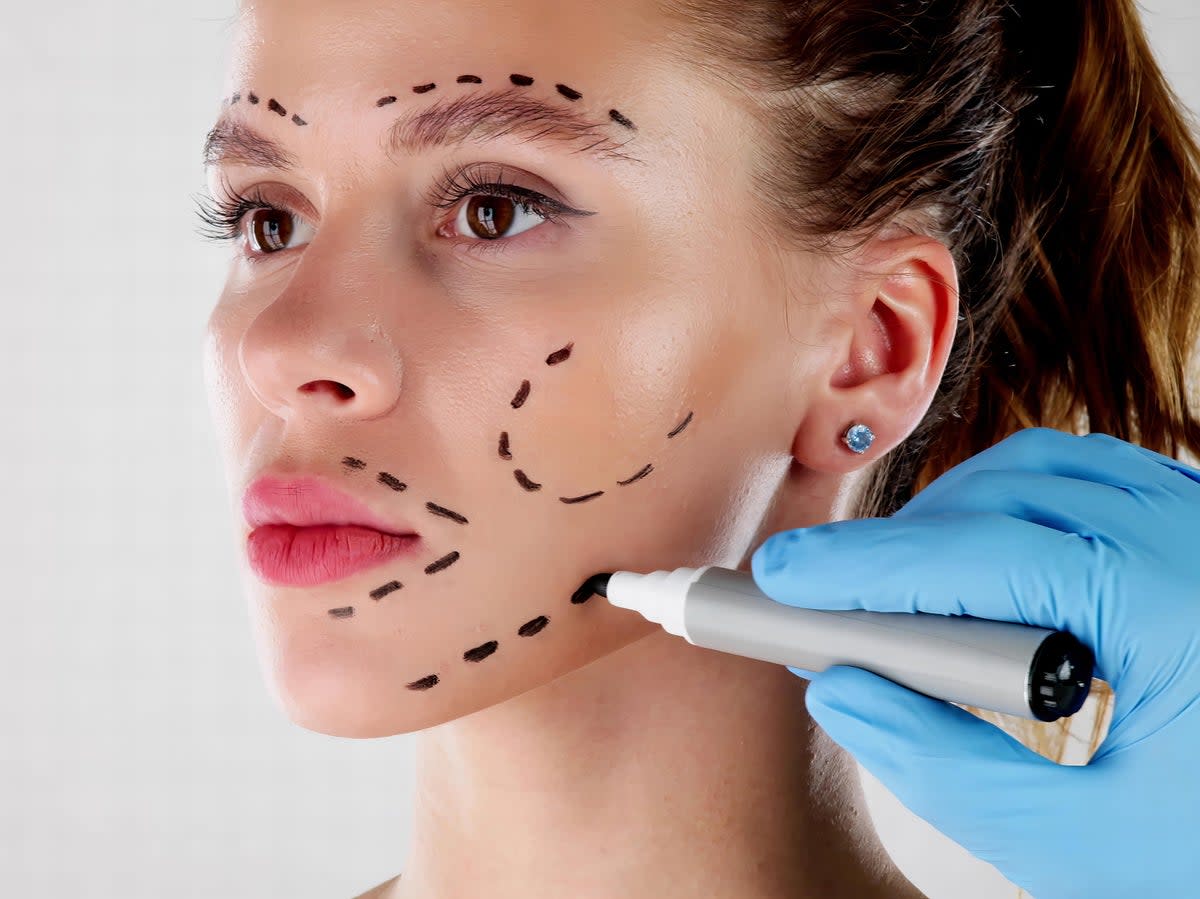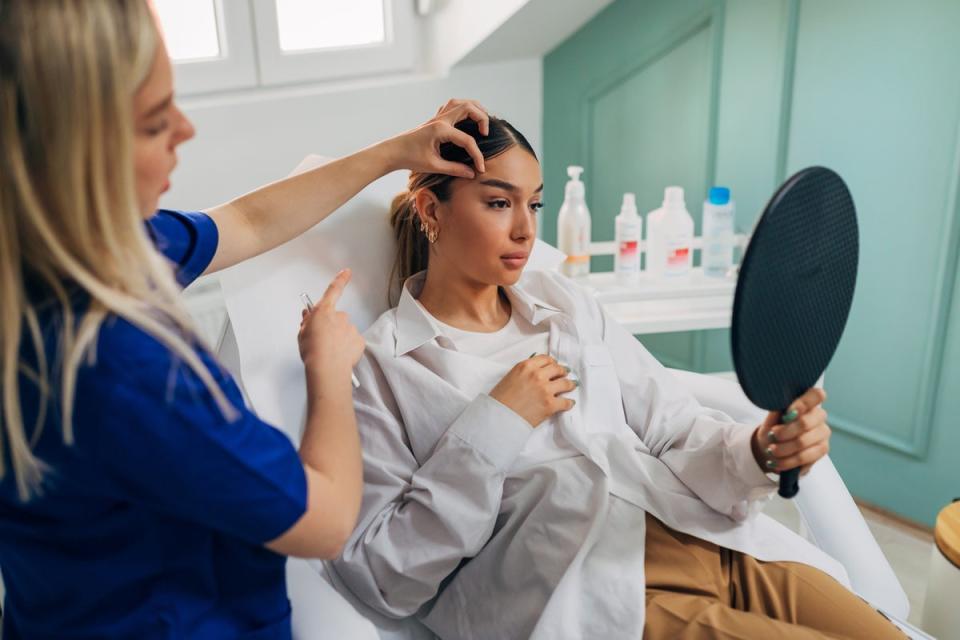Are we all going to end up with the same face?

Take a look at the faces around you. Notice anything? The shapes of people’s eyes all tilting up in the same way towards their hairline? Pouts that pucker up with perfect uniformity? Cheekbones that protrude almost violently through the skin? Perhaps you don’t notice any of these things, in which case you’re already too far gone. But if you do? Well, it’s only a matter of time until you become indoctrinated. Because in 2024 beauty is a homogenous ideal, one that none of us can escape from.
“It is the face of some of the most popular women in our digital realm, from Kylie Jenner to Kim Kardashian, Bella Hadid to Emily Ratajkowski, and has formed the foundation of a new beauty industrial complex, in which a single facial aesthetic is popularised and idealised for the mass market,” says Ellen Atlanta, author of the new book Pixel Flesh: How Toxic Beauty Culture Harms Women. “The result is a culture of homogeneous beauty, in which women covet each other’s features and strive for ideals that can only be achieved through augmentation – normalising injectable procedures, cosmetic surgery, photo editing and filter use in order to achieve the look (all of which have become increasingly accessible over the past decade).”
Those deeply embedded within this specific zone of the pop culture zeitgeist will be familiar with this idea already thanks to the term “Instagram Face”. Coined by writer Jia Tolentino in a viral 2019 piece for The New Yorker, the term reflected the “single, cyborgian look” requested by young women rushing into plastic surgery clinics. “It’s a young face, of course, with poreless skin and plump, high cheekbones,” writes Tolentino. “It has catlike eyes and long, cartoonish lashes; it has a small, neat nose and full, lush lips.”
Back then, this still felt like a fairly new phenomenon. It was shocking, perhaps, and relevant only to a few celebrity faces (Tolentino references Kendall Jenner and Emily Ratajkowski as examples), and a handful of high-profile social media influencers you followed online. Five years later, though, and Instagram Face is very much an offline reality, and one so deeply embedded into our culture that it doesn’t even feel strange anymore.
There are now endless filters people can access on any social media platform that show users what their faces would look like with various plastic surgeries. Using them is often part of a wider trend that parodies but also normalises a surgically enhanced aesthetic; how many people have you seen talking to the camera with comically large lips?
“The use of digital enhancement on social media is so commonplace nowadays that people use filters and apps to completely reshape their face and body and think that it’s normal,” says cosmetic surgeon Dr Paul Banwell. “You’re now able to quickly create a new version of yourself that is comparable to looking in the mirror every day. Because these filters and edits have become the norm among influencers and celebrities, it’s altering people’s perception of normal beauty ideals worldwide.”
People used to come to see me asking to look like a particular celebrity, but many patients come to me now wanting to look like the filtered version of themselves. I find that shocking. These filters just aren’t realistic
Dr Paul Banwell, cosmetic surgeon
But what are people actually having done? According to the British Association of Aesthetic Plastic Surgeons (BAAPS), women had 93 per cent of all cosmetic procedures in 2023. And while the majority of the most popular surgeries were bodily (breast augmentation and reduction were the top two), a surprising entry was blepharoplasty aka eyelid surgery. This was also one of the top five most popular procedures among men, who also favoured rhinoplasty and otoplasty, which is ear correction. Meanwhile, face and neck lift surgery increased across the board, becoming the sixth most popular treatment overall.
Elsewhere, Botox and dermal filler, both of which can drastically change one’s appearance, are surging in popularity, with UK dentists claiming they’ve benefitted hugely from the rise in demand; a 2022 audit by the BAAPS found that 6,639 Botox treatments were performed by its members, marking a 124 increase on the previous year.
Perhaps what’s more concerning, though, is not what’s being done, but what’s inspiring the work that’s being done.“People used to come to see me asking to look like a particular celebrity,” says Dr Banwell, “but many patients come to me [now] with a phone and show me pictures saying, ‘That’s how I get the most likes and followers – could we do that in reality. I’m tired of editing the picture.’ They want to look like the filtered version of themselves. I find that shocking. These filters just aren’t realistic. They will increase the size of a patient’s eyes, change the shape of the face entirely, not to mention wipe out imperfections where lines can’t be removed – the face just wouldn’t be able to show any emotion.”

Today’s surgery requests go far beyond the aforementioned mainstream treatments; there are procedures taking place most people wouldn’t even deem possible, let alone necessary or desirable. Take one look at any of the surgery trends on Instagram or TikTok and you’ll find thousands of videos with millions of views, in which doctors speculate over what celebrities have had done to their faces. The procedures range from cheek enhancements and brow lifts to buccal fat removal and eyelash transplants (yes, really). Then there’s canthopexy, aka “fox-eye surgery”, which involves lifting the outer corners of the eyes to create a more elongated, cat-like shape. And with many people seeking the same sorts of treatments, well, that’s what creates the single cyborgian look that Tolentino references.
“I think what’s most damaging in the cosmetic industry are doctors and clinics striving for a singular type of beauty,” says Dr Mark Solomos, TV plastic surgeon from Channel 4’s 10 Years Younger and ITV’s The Price of Perfection. “They might do a course on brow lifts and then all their patients have the same brow lift, whether it suits them or not. Treatments should always be targeted to the person to get the best outcome for them personally.”
It’s a dilemma for those actually performing the surgeries, given the ethical responsibility they have. “I have to try and stick to my beliefs that we are offering a bespoke and tailored service that enhances and improves the patient depending on so many differing facial factors, as of course no two faces are the same,” adds Dr Solomos. “This isn’t always easy when people see filtered faces and edited faces on Instagram and think this is the new normal – [but] there is no normal or perfect face for everybody. It’s fashion, and fashions come and go. When it comes to surgery, the results are often permanent.”
There are long-term ramifications at a wider societal level for all of this, too. “The pursuit of a singular beauty standard can be damaging because it fosters unrealistic ideals, leading to feelings of inadequacy and low self-esteem for those who don’t fit the mould,” says plastic surgeon Dr Fadi Hamadani. “It also perpetuates harmful stereotypes and biases, particularly affecting marginalised communities, and can drive people towards risky behaviours and extreme measures to conform.”
It’s also, Atlanta argues, a reductive, capitalist tactic. “Not only is it a genius marketing tool, as a globalised beauty standard creates an incredibly exclusive set of ideals that everybody must augment themselves in order to achieve, but it is also a tool of our collective oppression, a way to keep us in line,” she explains. “Uniformity has been used historically as a form of control and subordination: by conforming to copy/paste versions of one another, by assimilating into an assembly line of identical faces, we lose a sense of our individuality and of our humanity. It goes beyond aesthetics; it’s a political act that hinders our self-definition and ultimately strips us of agency.”

The rise in non-invasive treatments offering similar results to surgical ones – usually involving lasers, radiofrequency and microneedling – has also made achieving a tweaked “look” far easier, giving people the opportunity to achieve the same aesthetics without going under the knife. “We have seen increased requests for FaceTite, which tightens and contours the skin using radiofrequency technology, while Morpheus8 combines microneedling with radiofrequency to improve skin texture,” adds Dr Hamadani. “Both treatments offer versatility across different skin types and ages, delivering noticeable results with little discomfort or recovery time.”
In some ways, this could be considered a good thing – people can get the look they want without having to undergo major surgery – but perhaps it only exacerbates the central issue at play. Because if these sorts of aesthetics become more widely available, a tweaked and twisted face becomes more ubiquitous, subsequently raising the beauty standards even higher and further from reality.
Ultimately this is a problem that will only be solved by a tidal change in what society regards as beautiful. Rather than celebrating one aesthetic that we see all over Instagram, it’s about championing individuality and facial idiosyncrasies that make us who we are.
“Psychologically, societal pressures and media portrayal significantly shape these ideals, impacting individuals’ self-esteem and mental well-being,” warns plastic surgeon Dr Vahe Karimyan. “Encouraging self-acceptance and embracing diverse beauty standards is crucial for fostering healthier perceptions of beauty.”
The solution relies on visibility. And ensuring that what we’re seeing on our screens and smartphones are faces that represent those we see in our everyday lives. Not ones that have been created by crafty surgeons in Los Angeles, or overpriced aestheticians wielding high-tech lasers as weapons. Because if we don’t, soon the term “Instagram Face” will become entirely obsolete; whenever we see someone who has undergone various treatments and procedures, we won’t be able to tell. They’ll just look like everyone else. And the rest of us will be the exception.


